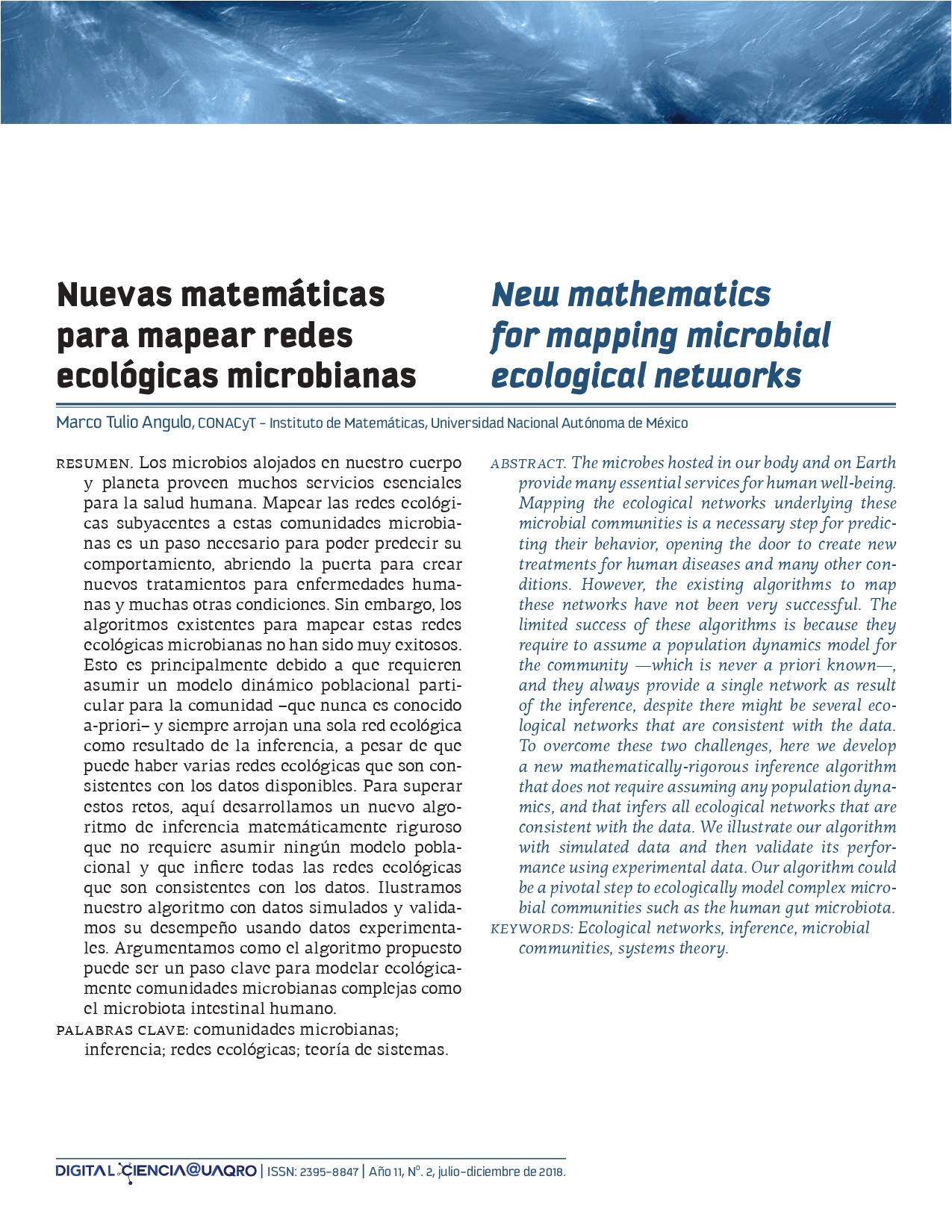Resumen
Los microbios alojados en nuestro cuerpo y planeta proveen muchos servicios esenciales para la salud humana. Mapear las redes ecológicas subyacentes a estas comunidades microbianas es un paso necesario para poder predecir su comportamiento, abriendo la puerta para crear nuevos tratamientos para enfermedades humanas y muchas otras condiciones. Sin embargo, los algoritmos existentes para mapear estas redes ecológicas microbianas no han sido muy exitosos. Esto es principalmente debido a que requieren asumir un modelo dinámico poblacional particular para la comunidad –que nunca es conocido a-priori– y siempre arrojan una sola red ecológica como resultado de la inferencia, a pesar de que puede haber varias redes ecológicas que son consistentes con los datos disponibles. Para superar estos retos, aquí desarrollamos un nuevo algoritmo de inferencia matemáticamente riguroso que no requiere asumir ningún modelo poblacional y que infiere todas las redes ecológicas que son consistentes con los datos. Ilustramos nuestro algoritmo con datos simulados y validamos su desempeño usando datos experimentales. Argumentamos como el algoritmo propuesto puede ser un paso clave para modelar ecológicamente comunidades microbianas complejas como el microbiota intestinal humano.
Referencias
Alivisatos, A. P., Blaser, M., Brodie, E. L., Chun, M., Dangl, J. L, Donohue, T. J, Jansson, J. K. (2015). A unified initiative to harness Earth’s microbiomes. Science, 350(6260), 507--508.
Angulo, M. T., & Slotine, J.-J. (2017). Qualitative stability of nonlinear networked systems. IEEE Transactions on Automatic Control, 62(8), 4080--4085.
Angulo, M. T., Moog, C. H., & Liu, Y.-Y. (2017). Controlling microbial communities: a theoretical framework. bioRxiv, 149765.
Angulo, M. T., Moreno, J. A., Lippner, G., Barabási, A.-L., & Liu, Y.-Y. (2017). Fundamental limitations of network reconstruction from temporal data. Journal of the Royal Society Interface, 14(127), 20160966.
Bashan, A., Gibson, T. E., Friedman, J., Carey, V. J., Weiss, S. T., Hohmann, E. L., & Liu, Y.-Y. (2016). Universality of human microbial dynamics. Nature, 534(7606), 259.
Bucci, V., Tzen, B., Li, N., Simmons, M., Tanoue, T., Bogart, E., . . . Liu, Q. (2016). MDSINE: Microbial Dynamical Systems INference Engine for microbiome time-series analyses. Genome biology, 17(1), 121.
Buffie, C. G., Bucci, V., Stein, R. R., McKenney, P. T., Ling, L., Gobourne, A., ... Viale, A. (2015). Precision microbiome reconstitution restores bile acid mediated resistance to Clostridium difficile. Nature, 517(7533).
Cao, H.-T., Gibson, T. E., Bashan, A., & Liu, Y.-Y. (2017). Inferring human microbial dynamics from temporal metagenomics data: Pitfalls and lessons. BioEssays, 27 (2).
Dietert, R. (2016). The Human Superorganism: How the Microbiome Is Revolutionizing the Pursuit of a Healthy Life.
Dubilier, N., McFall-Ngai, M., & Zhao, L. (2015). Create a global microbiome effort. Nature, 525(7575), 631--634.Faust, K., & Raes, J. (2012). Microbial interactions: from networks to models. Nature Reviews Microbiology, 10(8), 538.
Friedman, J., & Alm, E. J. (2012). Inferring correlation networks from genomic survey data. PLoS computational biology , 8(9), e1002687.
Friedman, J., Higgins, L. M., & Gore, J. (2017). Community structure follows simple assembly rules in microbial microcosms. Nature ecology & evolution, 1(5), 0109.
Guidi, L., Chaffron, S., Bittner, L., Eveillard, D., Larhlimi, A., Roux, S., ... R, J. (2016). Plankton networks driving carbon export in the oligotrophic ocean Nature, 532(7600), 365.
Hudson, L. E., Anderson, S. E., Corbett, A. H., & Lamb, T. J. (2017). Gleaning insights from fecal microbiota transplantation and probiotic studies for the rational design of combination microbial therapies. Clinical microbiology reviews, 30(1), 191--231.
Jost, C., & Ellner, S. P. (2000). Testing for predator dependence in predator-prey dynamics: a non-parametric approach. Proceedings of the Royal Society of London B: Biological Sciences, 267(1453), 1611-1620.
Ljung, L. (1998). System identifi cation. Springer.
Lozupone, C. A., Stombaugh, J. I., Gordon, J. I., Jansson, J. K., & Knight, R. (2012). Diversity, stability and resilience of the human gut microbiota. Nature, 489(7415), 220.
May, R. M. (1973). Qualitative stability in model ecosystems. Ecology, 54(3), 638--641.
Mueller, U., & Sachs, J. L. (2015). Engineering microbiomes to improve plant and animal health. Trends in microbiology, 23(10), 606--617.
Shreiner, A. B., Kao, J. Y., & Young, a. V. (2015). The gut microbiome in health and in disease. Current opinion in gastroenterology, 31(1), 69.
Steinway, S. N., Biggs, M. B., Loughran Jr, T. P., Papin, J. A., & Albert, R. (2015). Inference of network dynamics and metabolic interactions in the gut microbiome. PLoS computational biology, 11(6), e1004338.
Turnbaugh, P. J., Ley, R. E., Hamady, M., Fraser-Liggett, C. M., Knight, R., & Gordon, J. I. (2007). The human microbiome project. Nature, 449(7164), 804.
Widder, S., Allen, R. J., Pfeiff er, T., Curtis, T. P., Wiuf, C., Sloan, W. T., ... Shou, W. (2016). Challenges in microbial ecology: building predictive understanding of community function and dynamics. The ISME journal, 10(11), 2557.
Xiao, Y., Angulo, M. T., Friedman, J., Waldor, M. K., Weiss, S. T., & Liu, Y.-Y. (2017). Mapping the ecological networks of microbial communities. Nature Communications, 8(1), 2042.

Esta obra está bajo una licencia internacional Creative Commons Atribución-NoComercial 4.0.
Derechos de autor 2018 Digital Ciencia UAQ

